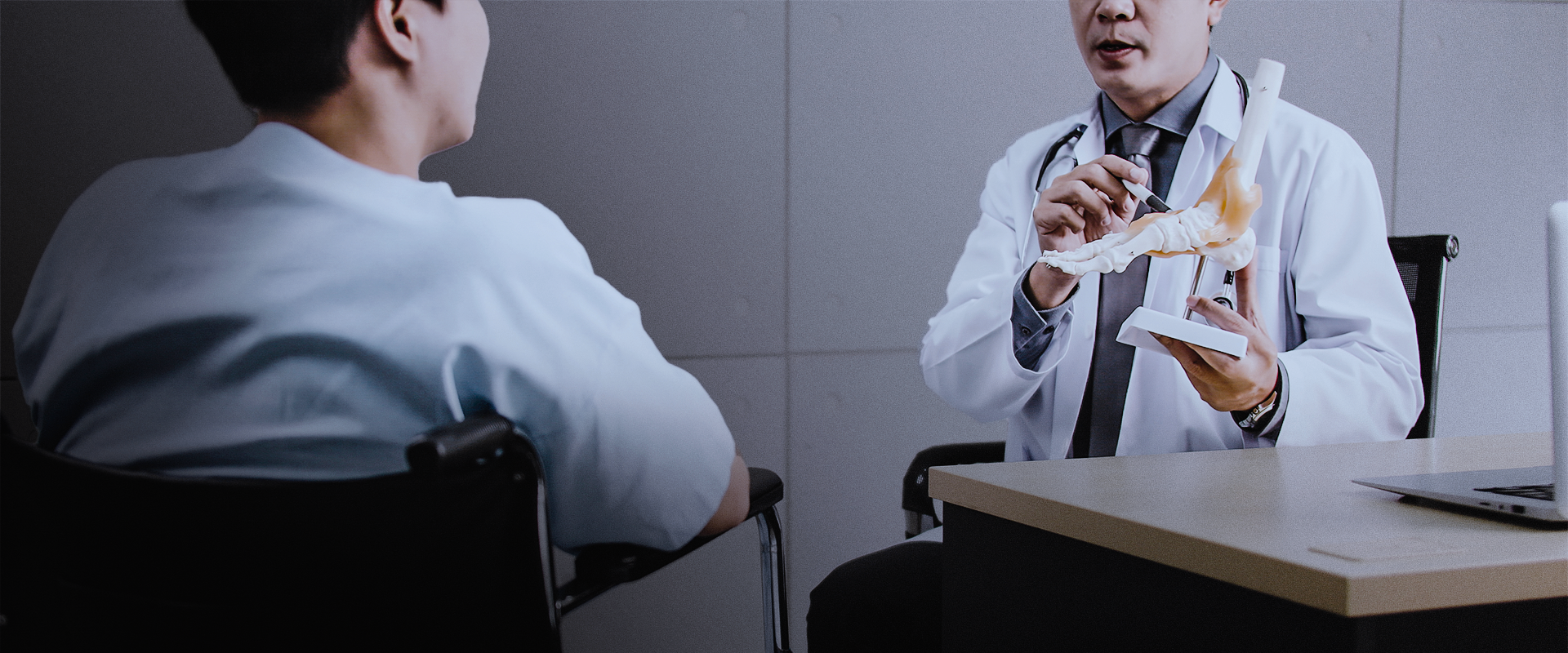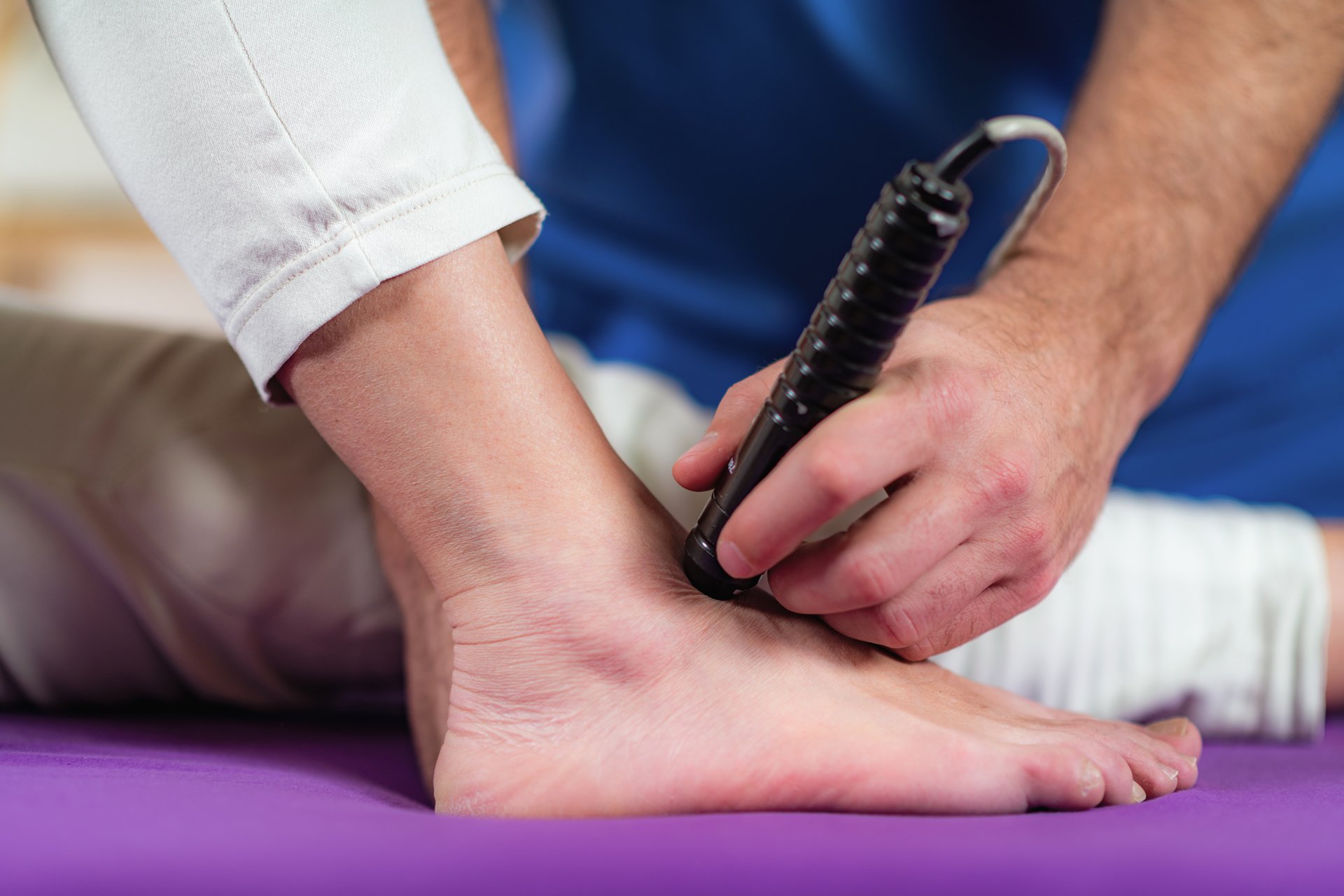
Rehab for Foot Surgery
AT EVOLVE
Rehab for Foot Surgery
HOW CAN PHYSICAL THERAPY HELP ME RECOVER FROM FOOT SURGERY?
Foot surgery can be a serious interruption to daily life but working with a physical therapist can help get you back on your feet. Following a surgery, the foot will need to undergo a period of recovery prior to returning to full activities. Physical therapy helps promote healing of the surgical area and return to full function through the use of manual therapy techniques, therapeutic exercises, neuromuscular re-education and more.
WHAT DOES PHYSICAL THERAPY FOR A FOOT SURGERY LOOK LIKE?
My team of physical therapists and I will help you recover from foot surgery. In the beginning your PT will work on reducing swelling in the foot and ankle, teach you how to use an assistive device to modify your weight bearing as needed and initiate return of muscle function and range of motion around the foot. As recovery progresses you will continue through a series of exercises to increase range of motion, improve strength and neuromuscular control, regain normal walking mechanics and then progress to sport-specific or more high impact training exercises like running, jumping or hiking.
HOW LONG WILL I NEED PHYSICAL THERAPY?
The duration of your physical therapy plan of care will vary depending on the type of surgery you had and any additional impairments that also need to be addressed. While full resolution of symptoms can take some time, you may begin to see some results right away. You should experience improvements in many symptoms such as pain, stiffness, and inflammation within a couple of weeks. Progression in strength, flexibility and overall mobility that allows you to stand and walk more comfortably, may take longer. Achieving long lasting results may take some time, but dedication to your program will help you achieve these results. Your PT will be able to give you a more specific timeline for recovery after your surgery and as you move through the rehabilitation process.
Common Foot Surgeries?
The foot can be divided anatomically into three sections. The hindfoot consists of the calcaneus (heel bone) and talus. The midfoot consists of five tarsal bones: three cuneiforms, the navicular and the cuboid. The forefoot consists of five long metatarsal bones which each connect to the bones of one toe. Many muscles, ligaments and tendons weave through the area to provide the optimal amount of movement and stability that our foot needs to perform weight bearing activities from standing to walking on a tight-rope. Pain, deformity and loss of function are some of the more common reasons that clients undergo foot surgery. While there are many types of foot surgeries, some of the more common foot surgeries are as follows:
Plantar Fasciitis Release: Plantar fasciitis, a condition caused by inflammation and microtrauma to the plantar fascia ligament running from the heel to the ball of the foot, sometimes does not respond to conservative management. When this is the case a surgeon might release the ligament from the heel bone to reduce pain and tightness.
Morton’s Neuroma Surgery: When tissues surrounding the nerves in the ball of the foot become thickened, they can form what is called a Morton’s Neuroma. This condition can cause burning or sharp pain in the toes or balls of the feet, numbness or tingling in the toes and the sensation of a “pebble” or small rock constantly in their shoe. To relieve pressure on the nerve space is made around the nerve and sometimes a small part of the damaged nerve is removed.
Bunion Repair: Bunions are caused by a condition called Hallux Valgus in which the big toe deviates toward the middle of the foot and causes a bony lump to develop on the inside of the base of the big toe. A surgery to straighten and stabilize the big toe is used to repair a bunion.
Hammer toe Reconstruction: Hammer toes are toes that have become clawed in appearance. The surgery for repairing hammer toes is either a replacement of the toe joints or a fusion of the toe joints so they lie flatter.
Fracture repair: plates and screws may be needed to stabilize a severe foot fracture if there is concern it will not heal adequately with only immobilization.
End Injury Progression
Physical therapy for foot surgery rehab has proven to prevent injury, slow and even stop pain issues, improve performance, and reverse injury progression in many cases.
Relieve Pain
The movements used in this technique can target your entire body helping you to manage discomfort and pain during the course of your physical therapy treatments.
Improve Range of Motion
Posture awareness is an important area to focus on due to the fact that certain positions may cause you further discomfort and pain.
Restore Mobility
You can regain mobility and flexibility by taking part in the stretches and exercises as prescribed by your physical therapist.
How Long Will Physical Therapy for Foot Surgery Rehab Treatments Last?
If you decide to work with a physical therapist to help with foot surgery rehab related issues, your entire treatment plan could consist of around 8-20+ different physical therapy sessions that will each last 60-90 minutes. Once you complete your customized physical therapy treatment plan, you will be able to continue to do the prescribed stretches and exercises utilized during your PT sessions yet in the comfort of your own home.
WHAT CAN I EXPECT FROM PHYSICAL THERAPY AFTER SURGERY?
The exact progression of your recovery will depend on the type of surgery you had. Some surgeries will require a period of foot and/or ankle immobilization to allow tissues to heal sufficiently before any stress is applied to them, while other surgeries will benefit from a more active recovery approach right away. Right after your surgery your physical therapist may use modalities, manual therapy techniques or gentle passive range of motion to address pain and inflammation and to preserve motion. As you progress through your recovery and the surgical site is allowed to undergo more stress, your program will likely include some of the following types of treatment in order to achieve your maximal level of function:
Strengthening: Restoring strength and endurance to the muscles around the foot, ankle and lower leg is an important part of post-surgical rehabilitation. It will reduce the risk of re-injury and help you return to your prior level of function.
Stretching: Stretching is often needed after a surgery to restore normal joint motion and muscle length but needs to be done carefully to prevent disruption of the healing process.
Neuromuscular Re-education: This type of treatment is used to improve the motor control and coordination of muscles around the foot and ankle so they function well and remain stable and strong during everyday activities.
Gait training: This type of treatment involves learning how to walk normally again following the surgery.
Balance: Balance is often affected by a foot or ankle injury and surgery, and you will likely be practicing balance exercises under a number of conditions following the surgery.
Power and Agility: In the late stages of post-surgical rehab it is important to address power and agility so that you can jump, run, cut and so forth.
Sport-specific Tasks: For athletes returning to sport, sport-specific exercises will be incorporated later on in your rehabilitation to prepare the foot for the demands of returning to play
Having any type of surgery can feel daunting but my team of physical therapists and I are here to help make that process as smooth as possible. Call Evolve today to get started on your recovery from foot surgery.
Mill Basin (located in Harbor Fitness)
6161 Strickland Ave
Brooklyn, NY 11234
Monday: 7am-8pm
Tuesday: 7am-8pm
Wednesday: 8am-5pm
Thursday: 7am-8pm
Friday: 8am-1pm
Park Slope (located in Harbor Fitness)
550 5th Ave.
Brooklyn, NY 11215
Monday: 9am-8pm
Tuesday: 8am-6pm
Wednesday: 9am-8pm
Thursday: 8am-6pm
Friday: 8am-3pm
Gravesend
372 Avenue U
Brooklyn, NY 11223
Monday-Thursday: 8am-8pm
Friday: 8am-3pm
Ready to take the next step to a healthier you?
Contact Us Today!
REHAB PHYSICAL THERAPY FOR FOOT SURGERY!
Need Rehab for Foot Surgery?
Let our caring and compassionate physical therapists help you with relieving pain while getting you back on your feet comfortably.
Call now to schedule your first PT consultation free of charge.
Call: 1-718-957-2422







